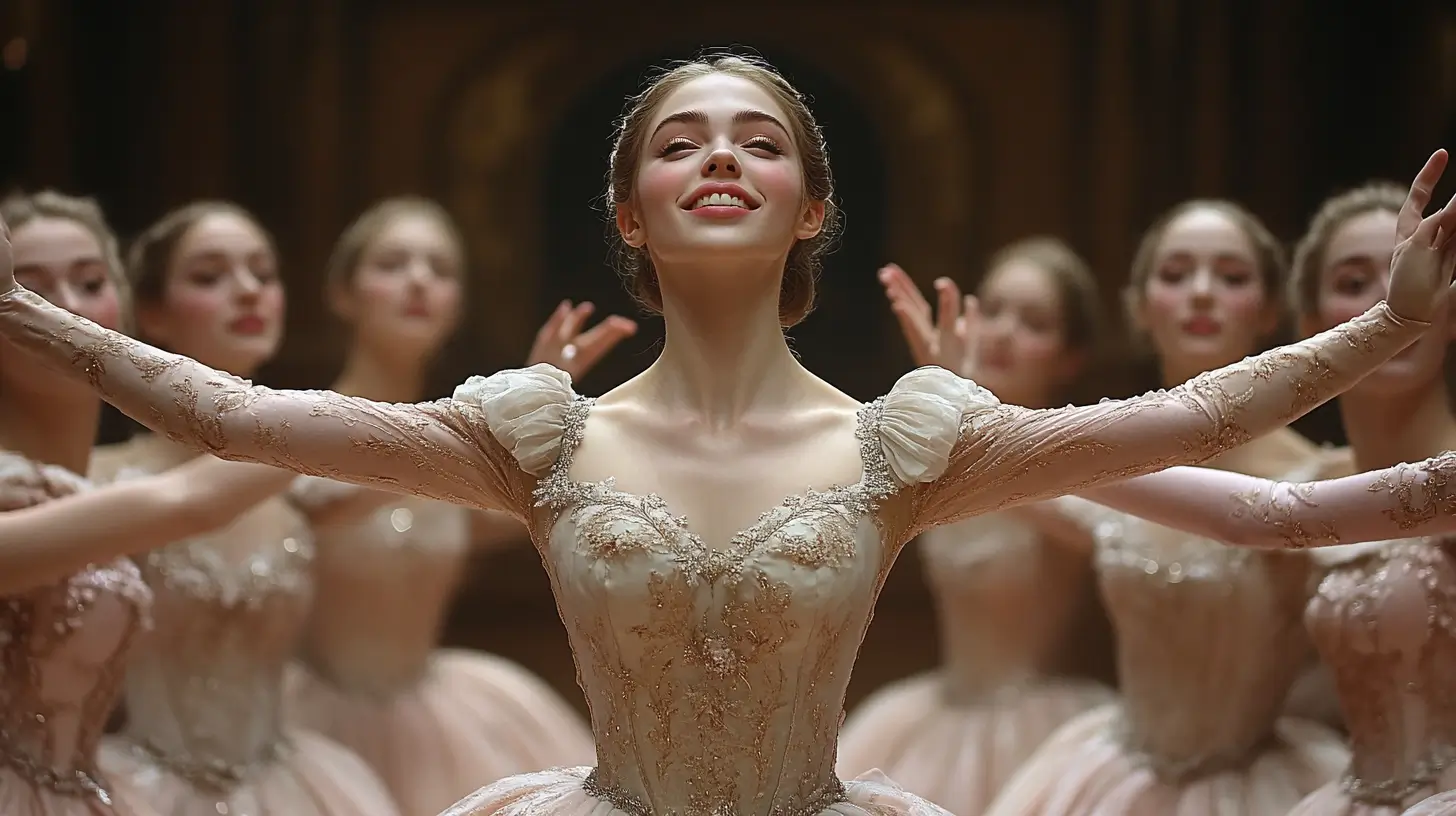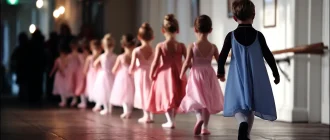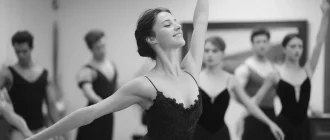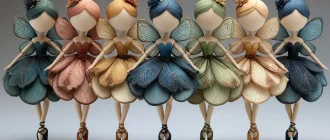Coppelia Ballet, a celebrated comic ballet from the 19th century, revolves around Swanilda, her fiancé Franz, and a mysterious doll named Coppélia. Blending humor, romance, and innovative choreography, it remains a timeless classic in ballet.
Graceful Insights
- Coppélia combines themes of love, mistaken identity, and humor, culminating in the joyful wedding of the protagonists, Swanilda and Franz.
- As a significant work in ballet history, Coppélia bridges the French Romantic and Russian Classical styles and has been revived numerous times to maintain cultural relevance.
- Modern interpretations, such as adaptations exploring technology and social media themes, demonstrate the timeless nature of Coppélia’s story and its adaptability to contemporary audiences.
Art de Podcast
| Aspect | Description |
|---|---|
| Title | Coppélia |
| Composer | Léo Delibes |
| Choreographers | Originally choreographed by Arthur Saint-Léon (1870); later interpretations by Marius Petipa, George Balanchine, and others |
| Librettists | Charles Nuitter and Arthur Saint-Léon, based on E.T.A. Hoffmann’s story “Der Sandmann.” |
| Premiere Date | May 25, 1870 |
| Premiere Location | Théâtre Impérial de l’Opéra, Paris, France |
| Style | Romantic and Comic Ballet |
| Duration | Approximately 1.5 to 2 hours, usually presented in three acts |
| Main Characters | – Swanilda: A lively young village girl, the ballet’s heroine – Franz: Swanilda’s love interest – Dr. Coppélius: The eccentric doll-maker |
| Plot Summary | Coppélia centers around Swanilda and her love interest, Franz. When Franz becomes captivated by Dr. Coppélius’s beautiful life-sized doll, Swanilda, jealous but curious, sneaks into the dollmaker’s workshop and takes the doll’s place. Through clever tricks and humor, she wins back Franz’s affection. The ballet explores love, jealousy, and the boundary between reality and illusion. |
| Notable Music Pieces | – Mazurka: Energetic folk dance scene – Waltz of the Hours: A dreamy interlude representing different times of day |
| Significance | Coppélia is celebrated for its joyful and lighthearted story, intricate dance sequences, and character-driven humor, marking it as a beloved comic ballet in the classical repertoire. |
| Popular Productions | Companies such as Paris Opera Ballet, Royal Ballet, and New York City Ballet frequently perform Coppélia, with adaptations highlighting local interpretations and modernized choreography. |
| Themes | Love and loyalty, curiosity, illusion vs. reality |
| Interesting Fact | Coppélia was one of the first ballets to blend classical ballet with folk dance elements, and it became an instant favorite, especially for its lighthearted tone after many tragic Romantic ballets. |
The Story of Coppélia
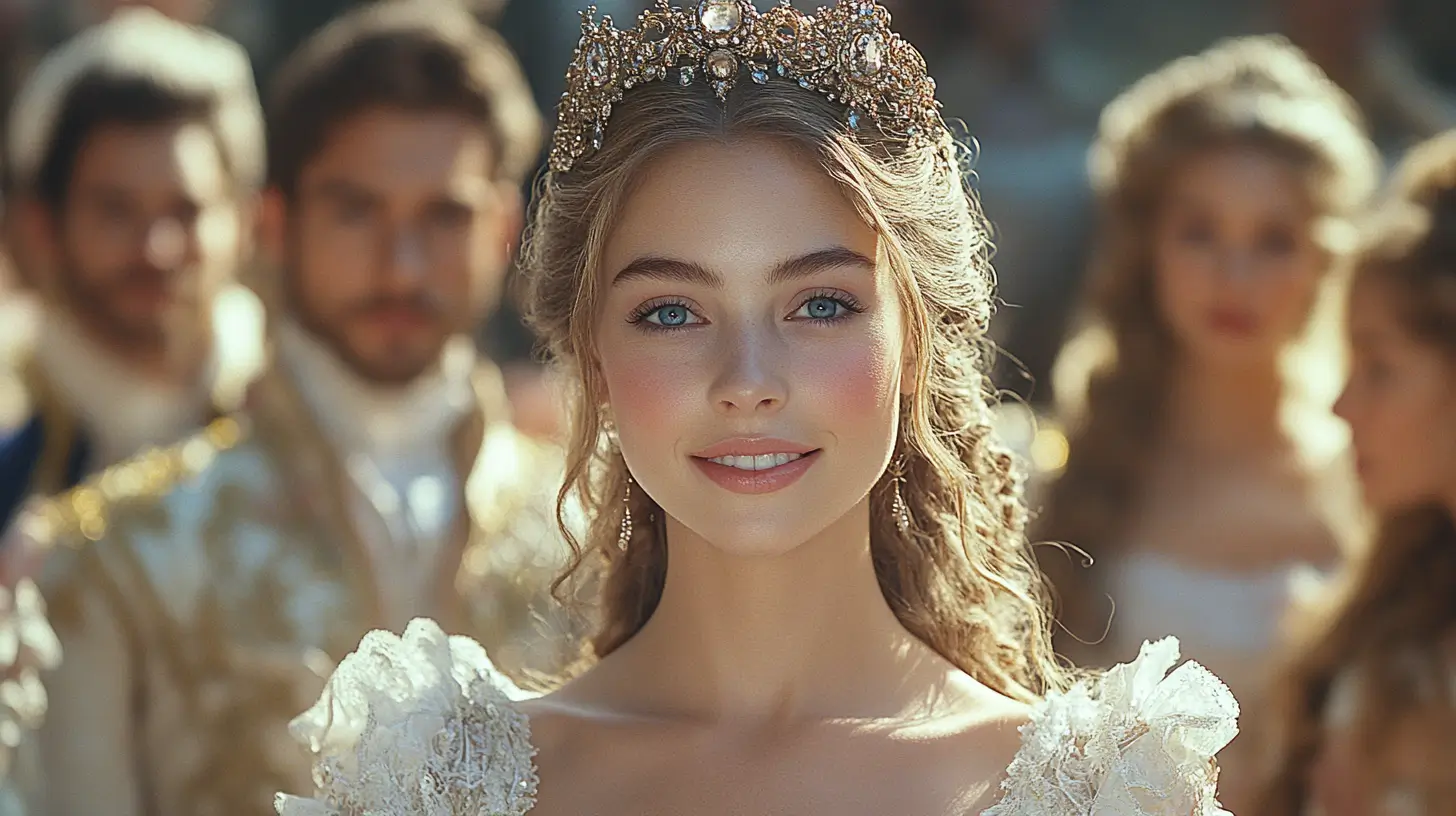
At the heart of Coppélia lies a tale of love, intrigue, and mistaken identity. Swanilda, the mayor’s daughter, questions the loyalty of her fiancé, Franz, who becomes infatuated with a mysterious coppélia girl perched on a balcony reading a book. This girl, Coppélia, seemingly springs to life, captivating Franz and creating a love triangle that drives the plot.
The story humorously explores themes of mistaken identity when Swanilda, determined to uncover the truth, sneaks into Dr. coppélius. Coppélius’s house, the workshop of the enigmatic dollmaker. She soon discovers that Coppélia is not a real girl but a beautiful mechanical doll created by Dr. Coppélius. With quick thinking, Swanilda dresses in Coppélia’s clothes and pretends to be the doll, fooling the doll maker, Dr. Coppélius, and Franz.
As the plot unfolds, Dr. Coppélius attempts to animate his beloved doll, believing he can transfer life from a human to Coppélia. This magical and slightly eerie endeavor adds a layer of intrigue to the story. Meanwhile, Franz sneaks into the doll- workshop, only to be caught by Dr. Coppélius, who sees an opportunity to use him in his experiment. However, Swanilda’s clever disguise helps her outwit the dollmaker and save Franz.
The opera house narrative’s third act concludes with a joyful wedding celebration, symbolizing the triumph of love and fidelity over jealousy and deception. The village gathers to celebrate the union of Swanilda and Franz with festive dances and a grand pas de deux highlighting the opera house’s final act.
Historical Significance
Coppélia is celebrated as one of the greatest comic ballets of the 19th century. Its unique blend of humor, romance, and fantasy distinguishes it from other ballets of its time. Additionally, ballet Coppélia bridges the gap between the French Romantic and Russian Classical styles, marking a pivotal moment in ballet’s evolution.
The ballet’s historical significance story, ballet, is further underscored by its various revivals. Marius Petipa’s 1884 restaging of Coppélia brought new life to the production, enhancing its presence in ballet history and ensuring its continued popularity. This restaging was a testament to the ballet’s enduring appeal and ability to adapt to different eras and styles.
George Balanchine’s addition of Coppélia to the repertoire of the New York City Ballet in 1974 marked a significant revival in the 20th century. Despite the company’s usual focus on innovative and abstract ballets, Balanchine’s staging of Coppélia was a nod to preserving classical narratives. This revival was crucial in maintaining Coppélia’s status as a frequently performed ballet in modern times.
Key Characters and Roles

The enchanting narrative of Coppélia is brought to life through its key characters: Swanilda, Franz, and Dr. Coppélius. Each character plays a vital role in shaping the story’s love, humor, and mistaken identity themes.
Swanilda, the mayor’s spirited daughter, is determined to uncover the truth about Coppélia. Her cleverness and bravery drive much of the plot as she sneaks into Dr. Coppélius’s workshop and disguises herself as the mechanical doll. Renowned ballerinas like Alexandra Danilova and Patricia McBride have portrayed Swanilda with remarkable charm and wit, making the character a beloved figure in ballet history.
Franz, Swanilda’s fiancé meets coppélia, is a character driven by curiosity and infatuation with girls. His fascination with Coppélia sets the story in motion, and his dancing adds a comedic element to the narrative. Many talented dancers have portrayed the character of Franz, each bringing their unique flair to the role.
Dr. Coppélius, the eccentric dollmaker, is both a figure of mystery and humor. His attempts to bring Coppélia to life add a magical and somewhat eerie dimension to the story. The character’s distinct role in the narrative balances the themes of love and fantasy, making him an integral part of the ballet’s charm, especially in dr coppélius’s house.
Structure and Acts
Coppélia is structured into three acts, each bringing a unique element to the story and contributing to the overall narrative arc. The first act sets the scene during a lively town festival. Swanilda and Franz are introduced, and Franz becomes infatuated with Coppélia, whom he believes to be a real girl. This act features key scenes such as the arrival of the town crier and Swanilda’s growing jealousy towards Coppélia, setting the stage for the unfolding drama.
The opera house’s second act occurs in Dr. Coppélius’s workshop, where Swanilda discovers the true nature of Coppélia. Disguised as the beautiful mechanical doll, Swanilda tricks Dr. Coppélius and Franz, leading to humorous and tense moments. This opera house’s third act is the story’s climax, with Swanilda’s cleverness and coppélius’s returns of bravery coming to the forefront.
The third act iii brings the narrative to a joyful conclusion with a grand wedding celebration. The village gathers to celebrate the union of Swanilda and Franz with festive dances and a grand pas de deux highlighting the final act ii of ballet. Dr. Coppélius’s demand for compensation for his lost doll adds a final twist, but the overall festival mood is happiness and community.
Music and Choreography

The music and choreography of Coppélia are integral to its charm and enduring popularity. The ballet’s score, composed by Léo Delibes, is celebrated for its lively and captivating melodies. léo Delibes’ music and dance also beautifully illustrate the ballet’s movement and character, enhancing the story’s narrative and emotional depth.
The choreography of Coppélia has evolved, with contributions from notable figures such as Arthur Saint-Léon, who originally choreographed one act of the ballet, and Marius Petipa, who later restaged it. The dances in Coppélia are known for their precision and grace, capturing the humor and fantasy of the story. Highlights of dancing, such as the grand pas de deux in the final act, showcase the skill and artistry of the dancers.
The New York City Ballet’s production of Coppélia, choreographed by George Balanchine, is a testament to the ballet’s enduring appeal. Balanchine’s staging brought a fresh perspective to the classic, blending traditional choreography with innovative elements. This production, along with others by Balanchine, has helped maintain Coppélia’s status as the most frequently performed ballet.
Modern Interpretations
Modern interpretations of Coppélia have reimagined the classic story to address contemporary themes and settings. One notable adaptation is Jean-Christophe Maillot’s Coppél-i-A, which presents Coppélia as an android with artificial intelligence in a dystopian society. This version explores the implications of love and technology, offering a fresh narrative perspective.
In Coppél-i-A, the choreography is noted for its beauty and the skillful enhancement of dancer movements. This adaptation incorporates a musical score that complements the original choreography for the modern setting and themes, creating a unique and engaging production.
Another recent adaptation is the 2021 film Coppelia, which addresses themes related to social media and the pressures of superficial beauty. These modern versions showcase the versatility of Coppélia’s story and its relevance to contemporary audiences. These adaptations keep Coppélia fresh and exciting for new generations by reinterpreting the classic tale.
Famous Productions

Coppélia has been a consistent presence in ballet coppélia repertoires since its premiere, showcasing its lasting appeal. Many Doctor coppélius well-known productions have significantly impacted audiences and performers alike.
George Balanchine’s production for the New York City Ballet in 1974 of coppélia derive is one such notable revival. Despite the company’s usual focus on innovative and abstract ballets, Balanchine’s staging of Coppélia was a nod to preserving classical narratives. His production brought a fresh perspective to the classic, blending traditional choreography with innovative elements.
Renowned dancers like Alexandra Danilova and Megan Fairchild have given iconic performances in the lead role of Swanilda. Danilova’s portrayal is often considered definitive, while Fairchild has reflected on how the role transformed her journey as a dancer. These performances and others have helped maintain Coppélia’s status as a frequently performed and beloved ballet.
Supporting the Arts
Supporting the arts, particularly ballet, is crucial for ensuring the sustainability and growth of this beautiful art form. Donations to ballet organizations help fund new productions, allowing companies to bring classical ballets like Coppélia to life for new audiences.
Attending ballet performances contributes directly to the financial health of ballet companies and promotes cultural enrichment. Experiencing live performances allows audiences to appreciate the skill and artistry of the dancers and musicians, fostering a deeper connection to the arts.
Engaging younger generations through dance programs is vital for the future of ballet. These programs introduce children and young adults to the joy of dance, nurturing the next generation of dancers and audiences. By supporting ballet, we ensure that classic works like Coppélia continue to inspire and enchant future generations.
Summary
Coppélia remains a timeless classic in ballet, captivating audiences with its enchanting blend of humor, romance, and fantasy. From its delightful story and historical significance to its key characters, structure, music, and choreography, Coppélia has become a cherished work in ballet repertoires worldwide.
The modern interpretations and famous productions of Coppélia highlight its versatility and enduring appeal. By supporting the arts and engaging with productions like Coppélia, we help preserve these cultural treasures for future generations. The magic of Coppélia lives on, continuing to inspire and delight audiences around the globe.
Frequently Asked Questions
What is the main plot of Coppélia?
The main plot of Coppélia centers on Swanilda and her fiancé Franz, who becomes entangled with a lifelike mechanical doll named Coppélia, resulting in a series of humorous misunderstandings. Ultimately, the story concludes with a joyous wedding celebration.
Why is Coppélia historically significant?
Coppélia holds historical significance as a premier comic ballet of the 19th century, effectively linking French Romantic and Russian Classical ballet styles. Its continual revival by influential choreographers such as Marius Petipa and George Balanchine underscores its enduring relevance in the dance repertoire.
Who are the key characters in Coppélia?
The key characters in Coppélia are Swanilda, a spirited village girl; Franz, her curious fiancé; and Dr. Coppélius, the village square eccentric dollmaker. Their interactions drive the narrative’s love, humor, and mistaken identity themes.
What are some modern interpretations of Coppélia?
Modern interpretations of Coppélia, such as Jean-Christophe Maillot’s Coppél-i-A, depict the character as an android in a dystopian setting. At the same time, the 2021 film Coppelia explores themes of social media and superficial beauty. These adaptations reflect contemporary concerns and highlight the timeless relevance of coppélia derived from the original story.
How can I support ballet and the arts?
To support ballet, dance, and the arts, consider donating to ballet organizations, attending performances, and engaging with educational dance programs for youth. Such involvement is crucial for the sustainability and growth of ballet.

